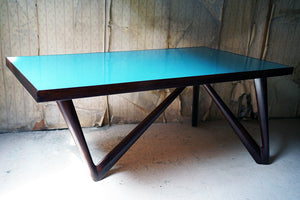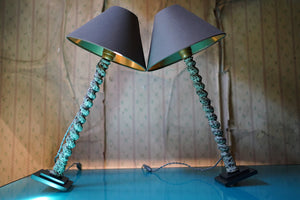Origin: American
Period: Mid 20thC
Provenance: Unknown
Date: c.1960
Height: 29”
Diameter: 42” (without leaf)
Depth: 42”
Width with Leaf: 62”
The good quality and ready to use extending dining table, morphing from a four-seater to a six, via an extra leaf, the beautifully grained timber showing a super colour, the whole designed by Edward Wormley (1907 – 1995) for renowned Indiana firm Dunbar, and surviving from the third quarter of the twentieth century.
The condition of the table is superb with the finish having recently been made pristine. The interlocking mechanism is in working order, with the piece stamped under; Dunbar Indiana and the number 2667. The timber used is an American native tree, similar to mahogany.
Revered for its handcrafted and highly collectible mid-century modern sofas, coffee tables and other furnishings, Dunbar Furniture was founded in 1910 in Berne, Indiana, but it didn’t gain widespread recognition until the ’30s, following the introduction of its president to a designer who would leave an indelible mark on the company’s legacy: Edward Wormley.
As the longtime director of design for the Dunbar furniture company, Edward Wormley was one of the leading forces in bringing modern design into American homes in the mid-20th century. Not an axiomatic modernist, Wormley deeply appreciated traditional design, and consequently his work has an understated warmth and a timeless quality that sets it apart from other furnishings of the era. Marshall Field hired Wormley in 1930 to design a line of reproduction 18th-century English furniture; the following year he was hired by the Indiana-based Dunbar, where he quickly distinguished himself. It was a good match.
Dunbar was an unusual firm: it did not use automated production systems; its pieces were mostly hand-constructed. For his part, Wormley did not use metal as a major component of furniture; he liked craft elements such as caned seatbacks, tambour drawers, or the woven-wood cabinet fronts. He designed two lines for Dunbar each year — one traditional, one modern — until 1944, by which time the contemporary pieces had become the clear best sellers. Many of Wormley’s signature pieces — chairs, sofas, tables and more — are modern interpretations of traditional forms.
During the peak of his design career and, indeed, the height of Dunbar Furniture’s history, Wormley amassed a whopping 30 Good Design awards between 1950 and 1955 through the “Good Design” exhibition, hosted by the Chicago Merchandise Mart and the Museum of Modern Art. Dunbar today still produces a limited selection of archival Wormley designs.
Presented in superb order this is a highly collectable and attractive piece of iconic furniture.
Period: Mid 20thC
Provenance: Unknown
Date: c.1960
Height: 29”
Diameter: 42” (without leaf)
Depth: 42”
Width with Leaf: 62”
The good quality and ready to use extending dining table, morphing from a four-seater to a six, via an extra leaf, the beautifully grained timber showing a super colour, the whole designed by Edward Wormley (1907 – 1995) for renowned Indiana firm Dunbar, and surviving from the third quarter of the twentieth century.
The condition of the table is superb with the finish having recently been made pristine. The interlocking mechanism is in working order, with the piece stamped under; Dunbar Indiana and the number 2667. The timber used is an American native tree, similar to mahogany.
Revered for its handcrafted and highly collectible mid-century modern sofas, coffee tables and other furnishings, Dunbar Furniture was founded in 1910 in Berne, Indiana, but it didn’t gain widespread recognition until the ’30s, following the introduction of its president to a designer who would leave an indelible mark on the company’s legacy: Edward Wormley.
As the longtime director of design for the Dunbar furniture company, Edward Wormley was one of the leading forces in bringing modern design into American homes in the mid-20th century. Not an axiomatic modernist, Wormley deeply appreciated traditional design, and consequently his work has an understated warmth and a timeless quality that sets it apart from other furnishings of the era. Marshall Field hired Wormley in 1930 to design a line of reproduction 18th-century English furniture; the following year he was hired by the Indiana-based Dunbar, where he quickly distinguished himself. It was a good match.
Dunbar was an unusual firm: it did not use automated production systems; its pieces were mostly hand-constructed. For his part, Wormley did not use metal as a major component of furniture; he liked craft elements such as caned seatbacks, tambour drawers, or the woven-wood cabinet fronts. He designed two lines for Dunbar each year — one traditional, one modern — until 1944, by which time the contemporary pieces had become the clear best sellers. Many of Wormley’s signature pieces — chairs, sofas, tables and more — are modern interpretations of traditional forms.
During the peak of his design career and, indeed, the height of Dunbar Furniture’s history, Wormley amassed a whopping 30 Good Design awards between 1950 and 1955 through the “Good Design” exhibition, hosted by the Chicago Merchandise Mart and the Museum of Modern Art. Dunbar today still produces a limited selection of archival Wormley designs.
Presented in superb order this is a highly collectable and attractive piece of iconic furniture.






















